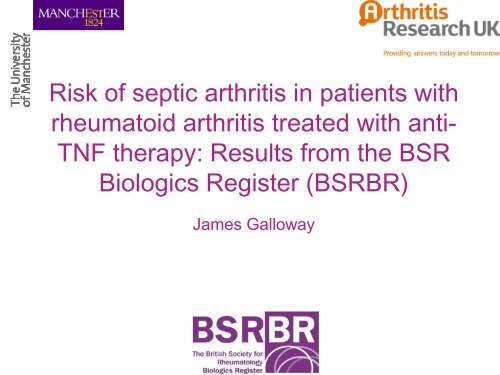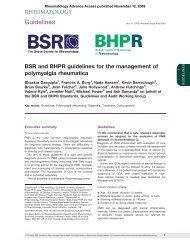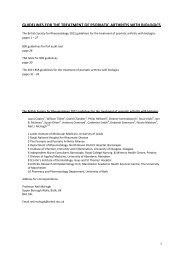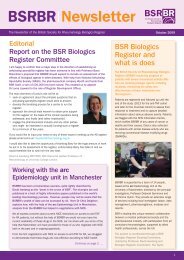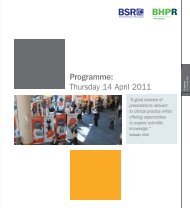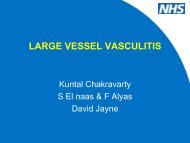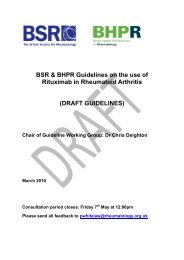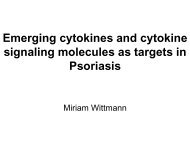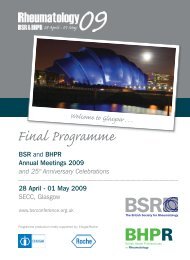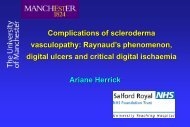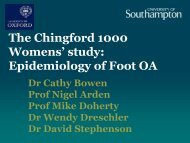Risk of septic arthritis in patients with rheumatoid - The British ...
Risk of septic arthritis in patients with rheumatoid - The British ...
Risk of septic arthritis in patients with rheumatoid - The British ...
Create successful ePaper yourself
Turn your PDF publications into a flip-book with our unique Google optimized e-Paper software.
<strong>Risk</strong> <strong>of</strong> <strong>septic</strong> <strong>arthritis</strong> <strong>in</strong> <strong>patients</strong> <strong>with</strong><br />
<strong>rheumatoid</strong> <strong>arthritis</strong> treated <strong>with</strong> anti-<br />
TNF therapy: Results from the BSR<br />
Biologics Register (BSRBR)<br />
James Galloway
BSRBR Disclosure Statement<br />
BSR receives restricted <strong>in</strong>come f<strong>in</strong>ancial support from Abbott Laboratories,<br />
Amgen, Biovitrum, Scher<strong>in</strong>g Plough, Wyeth Pharmaceuticals and Roche.<br />
This <strong>in</strong>come f<strong>in</strong>ances a separate contract between the BSR and the<br />
University <strong>of</strong> Manchester who provide and run the BSRBR.<br />
All decisions concern<strong>in</strong>g analysis, <strong>in</strong>terpretation and publications are made<br />
autonomously <strong>of</strong> any <strong>in</strong>dustrial contribution.<br />
(I have no personal disclosures or conflicts <strong>of</strong> <strong>in</strong>terest.)
Septic Arthritis<br />
• Septic <strong>arthritis</strong> (SA) <strong>in</strong>creased <strong>in</strong> RA<br />
Explanations:<br />
• RA itself a risk for <strong>in</strong>fection<br />
• Damaged jo<strong>in</strong>ts more susceptible to colonisation<br />
• Presence <strong>of</strong> jo<strong>in</strong>t prostheses<br />
• Immunosuppressive therapy
<strong>The</strong> role <strong>of</strong> TNF <strong>in</strong> host defense<br />
T lymphocyte<br />
Granuloma<br />
Formation<br />
Mycobacteria<br />
Macrophage<br />
TNF<br />
Listeria<br />
PLoS Image
Anti-TNF therapy and <strong>in</strong>fection<br />
5.0<br />
Follow up period <strong>of</strong> risk estimate<br />
Incident rate ratio (95% CI)<br />
2.0<br />
1.0<br />
1 2 3<br />
0.6<br />
Adapted from Askl<strong>in</strong>g & Dixon, Curr Op<strong>in</strong> Rheumatol, Volume 20(2).March 2008.138–144
Published evidence regard<strong>in</strong>g SA and<br />
anti-TNF therapy<br />
• RCT data<br />
– No signal apparent<br />
• Case reports<br />
– Unusual organisms<br />
• Observational studies
Aims<br />
• To establish the effect <strong>of</strong> anti-TNF therapy<br />
upon the risk <strong>of</strong> <strong>septic</strong> <strong>arthritis</strong><br />
• To describe the pattern <strong>of</strong> organisms seen<br />
• To analyse the temporal relationship<br />
between drug exposure and risk <strong>of</strong> SA
BSR Biologics Register<br />
• Prospective cohort <strong>of</strong><br />
UK <strong>patients</strong> treated <strong>with</strong><br />
anti-TNF therapy for RA<br />
• Commenced 2001<br />
“All cl<strong>in</strong>icians prescrib<strong>in</strong>g anti-TNF<br />
therapy for RA should (<strong>with</strong> the<br />
patient's consent) register the patient<br />
<strong>with</strong> the BSRBR”
BSR Biologics Register<br />
Control Cohort<br />
• Prospective cohort <strong>of</strong><br />
UK <strong>patients</strong> treated <strong>with</strong><br />
• Active RA<br />
anti-TNF therapy for RA<br />
• DMARD use<br />
• Anti-TNF Commenced naïve 2001<br />
• 29 centres<br />
• Identical follow-up
Data collection<br />
6 Monthly Annually<br />
Physician<br />
Questionnaire<br />
Patient<br />
Questionnaire<br />
& Diary<br />
NHS-IC<br />
Flagg<strong>in</strong>g<br />
6 Monthly<br />
Lifelong<br />
Year 0 Year 3 2013
Case validation<br />
• Physician confirmed cases only<br />
• NHS-IC reported on death certificate<br />
• Events classified serious<br />
– IV antibiotics<br />
– Hospitalisation<br />
– Death
Statistical methods<br />
• Multivariable Cox proportional hazard estimates were<br />
used to compare rates between cohorts<br />
• All events occurr<strong>in</strong>g on anti-TNF or <strong>with</strong><strong>in</strong> 90 days<br />
<strong>in</strong>cluded<br />
• Analyses adjusted for:<br />
– Age<br />
– Gender<br />
– Smok<strong>in</strong>g<br />
– Diabetes<br />
– Year <strong>of</strong> registration<br />
– Disease duration<br />
– DAS28<br />
– HAQ<br />
– Basel<strong>in</strong>e steroid use<br />
– Prior jo<strong>in</strong>t replacement
Basel<strong>in</strong>e characteristics<br />
DMARD Anti-TNF p-value<br />
Number <strong>of</strong> <strong>patients</strong> 3598 11798 -<br />
Mean age:<br />
Years (SD)<br />
60 (12) 56 (12)
Basel<strong>in</strong>e characteristics<br />
ETA INF ADA<br />
Number <strong>of</strong> <strong>patients</strong> 4219 3467 4202<br />
Mean age:<br />
Years (SD)<br />
56 (12) 56 (12) 57 (12)<br />
Females: % 77 76 76<br />
Median disease duration: Years<br />
(IQR)<br />
12 (6-19) 12 (6-19) 10 (5-18)<br />
Disease activity:<br />
• Mean DAS28 score (SD)<br />
Range 1-9<br />
• Mean HAQ (SD)<br />
Range 0-3<br />
6.6 (1.0)<br />
2.1 (0.6)<br />
6.6 (1.0)<br />
2.1 (0.6)<br />
6.5 (1.0)<br />
2.0 (0.6)<br />
Basel<strong>in</strong>e prior orthopaedic surgery 26 24 21
Results<br />
Septic Arthritis <strong>with</strong><strong>in</strong> the BSRBR<br />
Cohort Pyears fup N Incident rate / 1000<br />
pyears follow up<br />
All cases 202<br />
DMARD cohort 9,094 18 1.9<br />
All TNF cohort 36,230 184 5.1<br />
Individual drug rates<br />
Etanercept 15,784 92 5.8<br />
Infliximab 9,622 43 4.5<br />
Adalimumab 10,733 49 4.6
Hazard ratio for <strong>septic</strong> <strong>arthritis</strong> <strong>in</strong> anti-<br />
TNF exposed <strong>patients</strong><br />
Hazard estimate (95% CI)<br />
0 1 2 3 4<br />
2.0<br />
2.4<br />
1.9 1.8<br />
DMARD All Anti-TNF Etanercept Infliximab Adalimumab<br />
*Adjusted for age, gender, disease severity, smok<strong>in</strong>g, steroid exposure, prior jo<strong>in</strong>t replacement, entry year, diabetes
Pattern <strong>of</strong> cultured organisms<br />
Anti-TNF Cohort<br />
N=76<br />
DMARD Cohort<br />
N=7<br />
9%<br />
11%<br />
55%<br />
25%<br />
S. aureus<br />
Coag Neg Staph<br />
Streptococci<br />
Other<br />
43% 43% S. aureus<br />
Coag Neg Staph<br />
Other<br />
14%<br />
Analysis limited to laboratory proven cases:<br />
Adjusted Hazard Ratio 3.5 (1.4 – 9.0)
Event rate / 1000 patient years follow up<br />
2 4<br />
0<br />
<strong>Risk</strong> <strong>of</strong> <strong>septic</strong> <strong>arthritis</strong> <strong>in</strong><br />
anti-TNF cohort<br />
0<br />
1 2 3<br />
Years <strong>of</strong> follow up
Native jo<strong>in</strong>t <strong>in</strong>fection<br />
• Approximately 50% <strong>of</strong> <strong>in</strong>fections occurred <strong>with</strong><strong>in</strong><br />
native jo<strong>in</strong>ts <strong>in</strong> both cohorts<br />
DMARD<br />
Anti-TNF<br />
Adjusted HR for SA limited to native<br />
jo<strong>in</strong>ts only<br />
ref 2.5*<br />
(1.2 – 5.0)<br />
*Adjusted for age, gender, disease severity, smok<strong>in</strong>g, steroid exposure, prior jo<strong>in</strong>t replacement, entry year, diabetes
Summary<br />
• Significantly <strong>in</strong>creased rate <strong>of</strong> <strong>septic</strong> <strong>arthritis</strong> <strong>in</strong><br />
anti-TNF exposed cohort<br />
• Most <strong>in</strong>fections are due to typical pathogens<br />
found <strong>in</strong> jo<strong>in</strong>ts<br />
• TNF <strong>in</strong>hibition does confer susceptibility to some<br />
atypical species<br />
• <strong>The</strong> risk appears greatest <strong>in</strong> the first year <strong>of</strong><br />
therapy
Acknowledgements<br />
• UK Consultant Rheumatologists<br />
• UK Rheumatology Specialist Nurses<br />
• BSRBR Control Centre Consortium<br />
• <strong>British</strong> Society for Rheumatology<br />
• Wyeth, Scher<strong>in</strong>g-Plough, Amgen, Biovitrum,<br />
Abbott, Roche<br />
• Alan Silman<br />
Arthritis Research UK<br />
Epidemiology Unit:<br />
• Deborah Symmons<br />
• Kimme Hyrich<br />
• Kath Watson<br />
• Mark Lunt<br />
• Andrew Ustianowski<br />
• Will Dixon<br />
• Louise Mercer<br />
• Yvonne K<strong>in</strong>g<br />
• Katie McGrother<br />
• Pat Creighton<br />
• Lesley Albutt<br />
• Katy Evans<br />
• Steph Fanner<br />
• Flo Baluwa<br />
• James Anderson<br />
• Anthony Marshall<br />
• Lisa Liu<br />
• Ursula Patt<strong>in</strong>son


